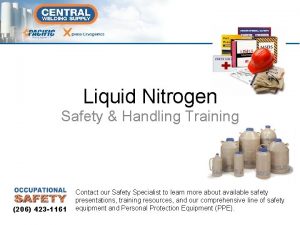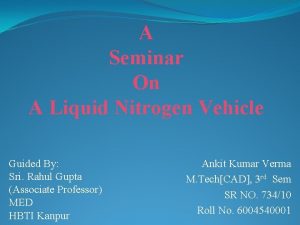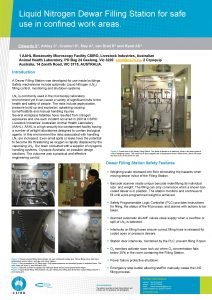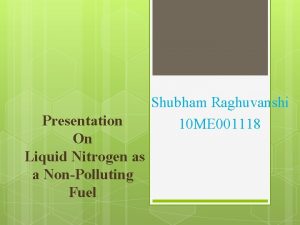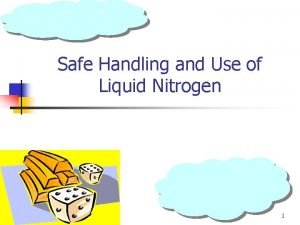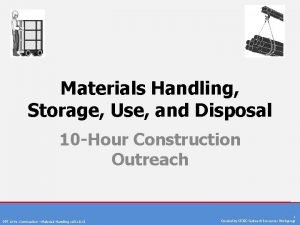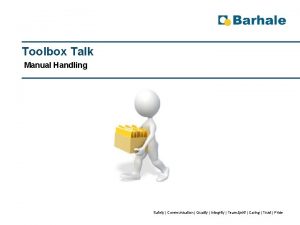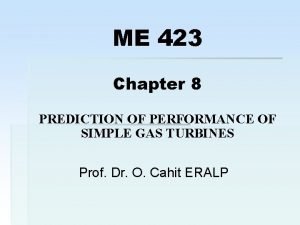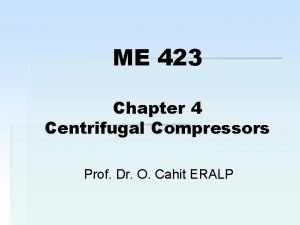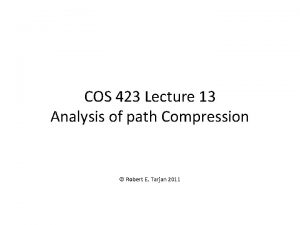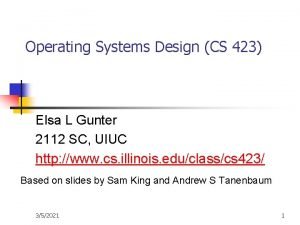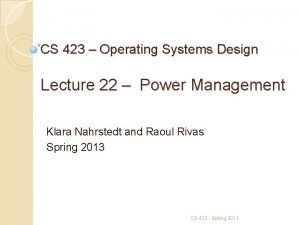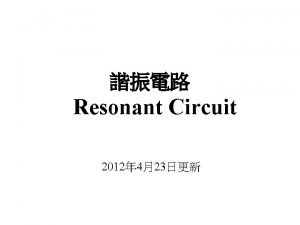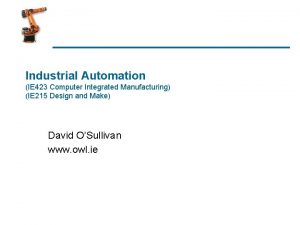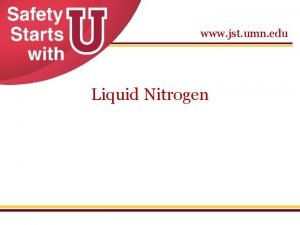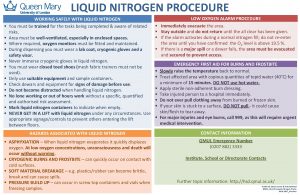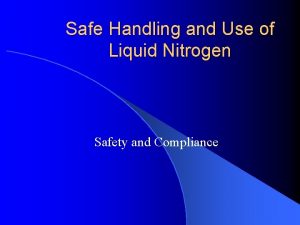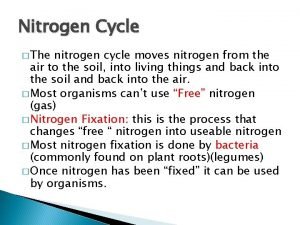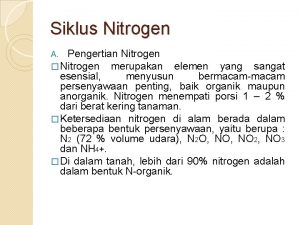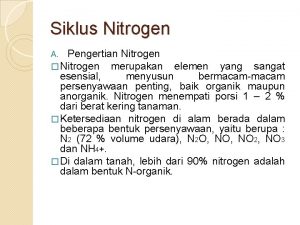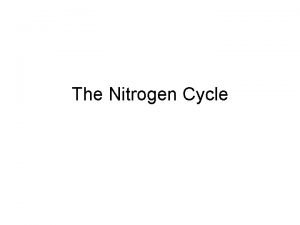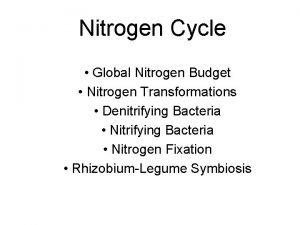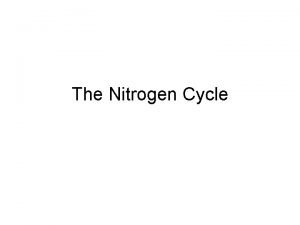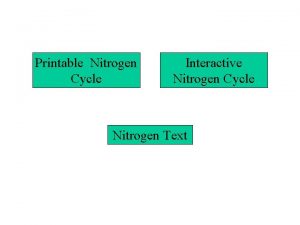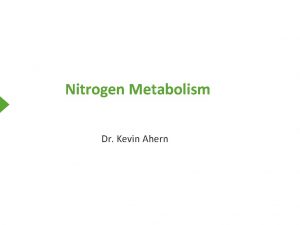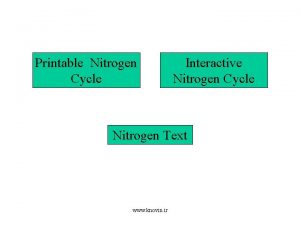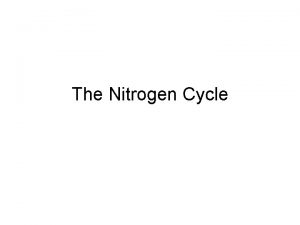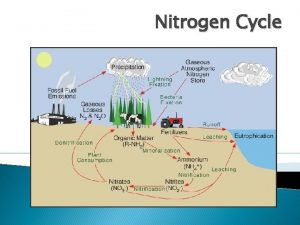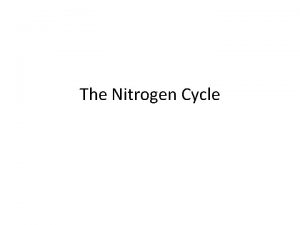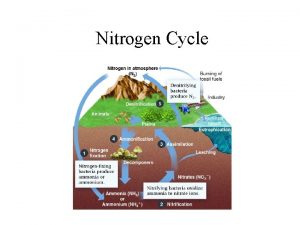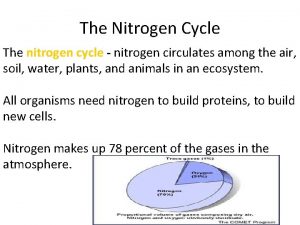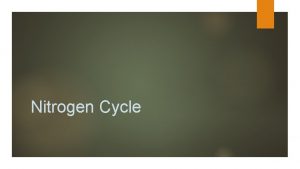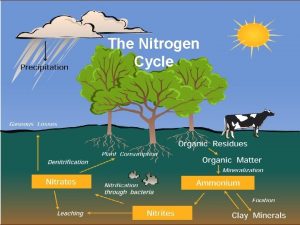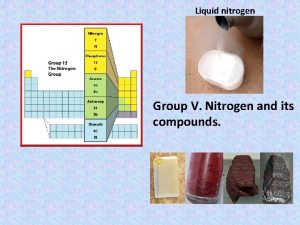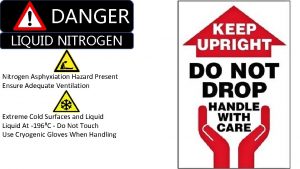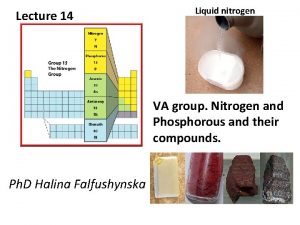Liquid Nitrogen Safety Handling Training 206 423 1161



























- Slides: 27

Liquid Nitrogen Safety & Handling Training (206) 423 -1161 Contact our Safety Specialist to learn more about available safety presentations, training resources, and our comprehensive line of safety equipment and Personal Protection Equipment (PPE).

Liquid Nitrogen Safety & Handling • Properties – – – APR 2010 a cryogenic liquid LN 2 colorless, odorless, tasteless Inert (mostly non-chemically reactive) boiling point -320. 4 F freezing/melting point -345. 8 F Liquid Nitrogen Safety & Handling

Liquid Nitrogen Safety & Handling • Valued for its coldness and inertness – Liquid nitrogen is the cheapest and most common “cryogenic liquid” – Nitrogen gas is inert, which means it won't readily react with other substances Cryogenics: Science concerned with the production of low temperatures, and how those temperatures affect different materials. The cryogenic temperature range is -238 ºF to about -460 ºF.

Liquid Nitrogen Safety & Handling • How Liquid Nitrogen is used today… – Freezing Food • Foods are packed and sealed, then sprayed with liquid nitrogen. The liquid evaporates on contact , absorbing all the food's heat and freezing it instantly. – Preserving Medical Specimens • Rapid freezing used to preserve different tissues, such as blood and bone marrow. Embryos, bacteria, and fungi are also stored in liquid nitrogen. – Super-Chilled Surgery • Exposure to cold temperatures can kill tissue in the human body (this is what frostbite is). “Cryomedicine" actually takes advantage of this by focusing extreme cold on unhealthy tissues, killing them. In cryosurgery, a super-chilled scalpel is used to cut unhealthy tissue away. This is already the standard treatment for some forms of skin cancer.

Liquid Nitrogen Safety & Handling • Liquid Nitrogen Hazards – Extreme Cold Hazard • brief exposure to skin can produce ‘thermal burns’ • prolonged exposure to skin cause frostbite • even more serious damage to delicate tissues such as the eyes • unprotected skin, stuck to cryogenically cooled metal or non-metal material, can tear away • prolonged breathing of extremely cold air can damage the lungs

Liquid Nitrogen Safety & Handling • Liquid Nitrogen Hazards – Asphyxiation Hazard • when cryogenic liquids form gas, the gas is very cold and usually heavier than air • cold, heavy gas does not disperse well and can accumulate near the floor • even if gas is non-toxic, it displaces air • lack of air (or oxygen in the air) can cause asphyxiation and death Extremely dangerous in enclosed or confined spaces!

Liquid Nitrogen Safety & Handling • Liquid Nitrogen Hazards – Explosion Due to Rapid Expansion • “boiling liquid expanding vapor explosion” (BLEVE) – improper venting on containers – faulty pressure-relief devices – accidental or unusual conditions » an external fire » incident that may cause break in the vacuum which provides thermal insulation

Liquid Nitrogen Safety & Handling • Storage Precautions – Must be stored in a Dewar • non-pressurized, vacuum-jacketed vessels (similar to a thermos bottle) consists of outer and inner layer separated by a vacuum • loose fitting cap or plug – prevents air and moisture from entering – allows excess pressure to vent Not all Dewars are rated for liquid nitrogen. Always follow manufacturers' guidelines for use of cryogen vessels of any size.

Liquid Nitrogen Safety & Handling • Storage Precautions – DO NOT use open, un-insulated or glass containers!

Liquid Nitrogen Safety & Handling • Extreme Cold Precautions – Hand protection and goggles (not safety glasses) are to be worn when dispensing and handling liquid nitrogen; nitrogen can spatter (possibly in eyes) while being poured, and flying chunks of frozen objects could cause eye injury – Stress the importance of not touching frozen objects or nitrogen to any potential onlookers (out of curiosity, people want to touch nitrogen or other cold objects)

Liquid Nitrogen Safety & Handling • Extreme Cold Precautions – When handling large quantities, a full length apron will minimize a spill going into your shoes (where it might destroy some cubic centimeters of flesh before you can get your shoes off) – Use a glove and/or tongs to handle any object going into or out of nitrogen, and to carry the nitrogen Dewar

Liquid Nitrogen Safety & Handling • Extreme Cold Precautions – Persons using a tipper to dispense LN 2 must wear • a full face shield over goggles • cryo-gloves • full length cuffless trousers, which completely cover the tops of the shoes (or a full length apron), • shoes which will not permit liquefied gas to enter them in case of a spill, and which are also quickly removable in case they do (allow liquid to enter)

Liquid Nitrogen Safety & Handling • Precautions for Dispensing Liquid Nitrogen – Remove metal jewelry before handling or dispensing liquid nitrogen (rings, bracelets, watches from hands/wrist) – Always wear goggles and cryo-gloves for dispensing ; never hold a vessel with unprotected hands while filling with liquid nitrogen – Persons filling dewars should wear full length noncuffed trousers (covering tops of shoes) or full length apron, and shoes which will not admit spilled cryogen and which are easy to remove quickly

Liquid Nitrogen Safety & Handling • Precautions for Dispensing Liquid Nitrogen – If the receiving vessel is small enough to be placed on the adjustable, adjust the table so that the delivery is immediately at the mouth of the receiving vessel (i. e. , do not allow liquid nitrogen to fall through a distance to reach the receiving vessel) – If the vessel is too large for the table, or the table is missing or inoperable, other provisions must be made for safely raising the vessel up to the delivery tube – DO NOT move/bend the copper fill tube; wear may eventually cause tube to break

Liquid Nitrogen Safety & Handling • Precautions for dispensing liquid – Nitrogen is to be dispensed only into smaller Dewars which either (a) have carrying handles or (b) are on wheels or (c) are 500 ml or smaller, and which have pressure relief valves or pressure venting lids. A wide -base Dewar which is stable on a wheeled cart qualifies as "on wheels. “ – Persons filling must be in constant attendance to the filling operation – Do not use a funnel; in the event the hole freezes closed it may cause spatter into face or eyes

Liquid Nitrogen Safety & Handling • Precautions for transporting liquid nitrogen – Use large mobile dewars where the need exists to transport liquid nitrogen (i. e. between rooms or buildings) – Wheeled trolleys may not be used if the vessel must pass over elevator thresholds or other slots/crevasses wider than 25% of the wheel width. – Transport should be equipped with a braking mechanism – do not use feet to brake – Steel toed boots are recommended – Take care to avoid crushing hands or fingers between the vessel or cart and walls or door frames

Liquid Nitrogen Safety & Handling • Precautions for transporting liquid nitrogen – Outdoor transport of large nitrogen dewars • a 4 -wheel tipcart should be used (the casters welded to the tank or on the trolley are not meant for transport over pavement and concrete) • exercise great care enroute; stay clear of sewer grates, large cracks, and/or uneven portions of the pavement, which could catch a cart wheel and cause tipping – Indoor transport from room to room • use Dewars with carrying handles (4 lb and less), or are on wheels (larger Dewars), and have pressure relief valves or pressure venting lids

Liquid Nitrogen Safety & Handling • Precautions for transporting liquid nitrogen – For short distances it is acceptable to hand-carry a pint (500 ml) or smaller Dewar of nitrogen which has no handles, if and only if… • the Dewar is your ONLY load (no books, no coffee), and • the vessel has a venting lid (cork, or loose stopper) and • you watch for people who will run into you, and • you use both hands to carry the vessel, as far away from your face as comfortably possible

Liquid Nitrogen Safety & Handling • Precautions for transporting liquid nitrogen – Do not carry liquid nitrogen in a passenger elevator – Only transport liquid nitrogen in the freight elevator with no other occupants present. – Only use containers that have been designed specifically for cryogenic liquids. – Do not store in a confined space. – Do not store at temperatures above 125°F.

Liquid Nitrogen Safety & Handling • Asphyxiation Precautions – Avoid using liquid nitrogen in a confined space without the use of the respirator • the ‘heavier nitrogen gas’ may reduce oxygen in the air to an unsafe breathing level – Take precautions regarding ventilation in the event of an accidental spill of liquid nitrogen • If the contents of a 10 liter dewar was spilled in an unventilated 274 sq ft room with an 8 ft ceiling, the oxygen would be reduced below the 19. 5% level where the risk of suffocation is present

Liquid Nitrogen Safety & Handling • Asphyxiation Precautions – Being odorless, colorless, tasteless and nonirritating, nitrogen has NO WARNING PROPERTIES! – Humans possess NO SENSES THAT CAN DETECT the presence of nitrogen. – Although nitrogen is nontoxic and inert, it can act as a simple asphyxiate by DISPLACING OXYGEN IN AIR to levels below that required to support life.

Liquid Nitrogen Safety & Handling • Asphyxiation Precautions – Death may result from lack of oxygen, due to symptoms that include • errors in judgment or confusion, or • loss of consciousness that prevents self-rescue – Personnel, including rescue workers, should not enter areas where the oxygen concentration is below 19. 5%, unless provided with a self-contained breathing apparatus or air-line respirator.

Liquid Nitrogen Safety & Handling • Asphyxiation Precautions – Nitrogen is not poisonous. The air is already about 78% nitrogen (oxygen makes up about 21%, and trace gases the remaining 1%). – If sufficient liquid nitrogen is vaporized, reducing the oxygen to below 19. 5%, you are at risk of oxygen deprivation. – Rapid venting can cause near-total displacement of normal air, leading to a local concentration of about 100% nitrogen. REMEMBER: Nitrogen does not have good warning properties! You might NOT feel "light-headed, " you may simply pass out without any warning and then die without regaining consciousness.

Liquid Nitrogen Safety & Handling • Explosion (BLEVE) Precautions – Guard against pressure build-up by using a pressure relief vessel or a venting lid – Glass Dewars must be taped solidly around the outside. The plastic mesh with which some small thermoses are sold protects the Dewar itself to an extent, but does not protect against injury from glass shards resulting from implosion – Cryotubes containing samples stored under liquid nitrogen may explode without warning. Tube explosions are thought to be caused by liquid nitrogen entering the tube through minute cracks and then expanding rapidly as the tube thaws. Serious accidents have occurred due to cryotube failures. A researcher in California lost an eye; numerous others have suffered plastic shards embedded in their hands and faces.

Liquid Nitrogen Safety & Handling • HAVE A PLAN! – At all times, know what you will do if… • A pressurized dewar spontaneously vents • You freeze your watchband or wedding band to your finger • The funnel (which you should not use) freezes and spews nitrogen upward into your face • An 160 liter LN 2 for whatever reason, falls onto its side (It happens. It is scary and unpleasant and could easily be quite disastrous)

Liquid Nitrogen Safety & Handling • EMERGENCY FIRST AID – If cryogenic liquid or cold boil off contacts a worker’s skin or eyes, frozen tissues should be flooded or soaked with TEPID water (105 -115 F, 41 -46 C) – DO NOT USE HOT WATER – Cryogenic burns which result in blistering or deeper tissue freezing should be seen promptly by a physician

Liquid Nitrogen Safety & Handling • PUBLIC SAFETY – Immediately call emergency personnel in the event of a large spill or leak. – Isolate large spills or leaks for at least 100 meters in all directions. – Keep unauthorized personnel away. – Stay upwind. – Keep out of low areas. – Ventilate closed spaces before entering.
 Liquid nitrogen safety training
Liquid nitrogen safety training Liquid nitrogen vehicle
Liquid nitrogen vehicle Liquid nitrogen fill station
Liquid nitrogen fill station Iqf spiral freezer
Iqf spiral freezer Liquid nitrogen powered car
Liquid nitrogen powered car Safety care training
Safety care training Various theories of breakdown in liquid dielectrics
Various theories of breakdown in liquid dielectrics Liquid liquid extraction unit
Liquid liquid extraction unit Nitrogen safety precautions
Nitrogen safety precautions A way to prevent materials handling hazards is to ___.
A way to prevent materials handling hazards is to ___. Tool box talk on manual handling
Tool box talk on manual handling Cse 423
Cse 423 Cse 423
Cse 423 877-423-7243
877-423-7243 Dimethiconol chemical formula
Dimethiconol chemical formula Me 423
Me 423 Me 423
Me 423 Data structures princeton
Data structures princeton Kevin wayne princeton
Kevin wayne princeton Cos 423
Cos 423 Uiuc cs 423
Uiuc cs 423 Cs 423
Cs 423 Uiuc cs 423
Uiuc cs 423 Ai 423
Ai 423 Ece 423
Ece 423 Cont 423
Cont 423 Rlc frequency
Rlc frequency Fixed automation diagram
Fixed automation diagram
